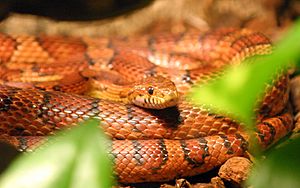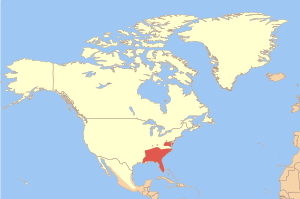Corn snake facts for kids
Quick facts for kids Corn snake |
|
|---|---|
 |
|
| Conservation status | |
| Scientific classification | |
| Genus: |
Pantherophis
|
| Species: |
guttatus
|
 |
|
| Synonyms | |
|
|
The corn snake (Pantherophis guttatus) is a type of rat snake that lives in North America. These snakes are known for squeezing their small prey to catch it.
You can find corn snakes across the southeastern and central United States. They are very popular as pets because they are gentle. They usually grow to be about 3.9 to 6.0 feet (1.2 to 1.8 meters) long. In the wild, they live for about 6 to 8 years. But when kept as pets, they can live much longer, sometimes over 23 years!
Contents
Why Corn Snakes Make Great Pets
Corn snakes are one of the most common snakes kept as pets. They are often chosen along with garter snakes and ball pythons.
Are Corn Snakes Dangerous?
Corn snakes are completely harmless to humans. They do not have venom, which means they are not poisonous. Sadly, corn snakes sometimes look similar to the venomous copperhead snake. Because of this, people sometimes mistake them for copperheads and harm them.
How to Tell Them Apart
It's easy to tell a corn snake from a copperhead once you know what to look for. Corn snakes have brighter colors and a thinner body. They also don't have the special heat-sensing pits that copperheads have on their faces. Corn snakes are actually helpful to people because they eat rodents that can damage crops and spread diseases.
What Do Corn Snakes Look Like?
Corn snakes are famous for their bright red-orange scales. However, sometimes they can have different colors due to natural changes.
Understanding Color Changes
There are two main color changes that can happen in corn snakes:
- Albinism: Snakes with albinism don't have black color in their scales.
- Anerythrism: Snakes with anerythrism don't have red color in their scales.
These changes make each corn snake unique and beautiful!
The Story Behind Their Name
The corn snake gets its name for a couple of interesting reasons.
Hunting Near Grain Stores
One idea is that they are often found near places where grain is stored. They like to hunt mice and rats that eat the harvested corn. The Oxford English Dictionary shows this name was used as early as 1675.
Belly Patterns Like Corn
Another idea is that the special checkerboard pattern on the snake's belly looks like the kernels of variegated corn. No matter how they got their name, the word "corn" can help you remember them!
What Do Corn Snakes Eat?
In the wild, corn snakes mostly eat rodents. They also enjoy small amphibians, birds, and their eggs. They are not known to eat insects.
Feeding Pet Corn Snakes
If you have a corn snake as a pet, they are usually fed small mice. These are often called "pinky mice" when they are very young. They can also eat other small creatures like those they would find in the wild.
Images for kids
-
A calm young corn snake found on the island of Nevis.
See also
 In Spanish: Serpiente del maíz para niños
In Spanish: Serpiente del maíz para niños












